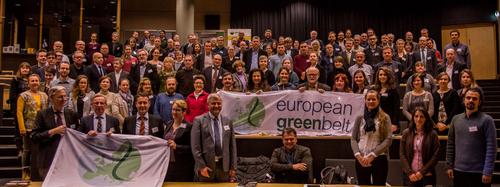
Clear message: The green infrastructure of the Green Belt along the former Iron Curtain has to be preserved and restored!
© European-Green-Belt-AssociationPan-European Green Belt Conference sets signals for cross-border nature conservation
Press release, 7 November 2016
Radolfzell. The 9th Pan-European Green Belt Conference sent a clear message for cross-border cooperation in European nature conservation and for a stronger connection between human beings and nature. More than 125 representatives of nature conservation administrations and organisations, scientists and nature conservationists met from 31 October to 3 November in Koli National Park in Finland, not far from the Russian border, to intensify cross-border cooperation along the European Green Belt. The eponymous initiative is currently the most ambitious one in Europe. It intends to transform the former Iron Curtain into a line of life and thus makes a substantial contribution to the preservation of the green infrastructure of our continent.
The analysis of the conference participants clearly shows that throughout Europe precious habitats are strongly fragmented. Especially traffic routes and settlements, but also intensive forms of use in agriculture and forestry contribute to a fragmentation of high-quality natural areas. According to experts, global and European goals of biodiversity conservation will only be achieved, if the European Union, its member states and also neighbouring countries massively increase their investments in European green infrastructure. Special attention should be given to the connection between precious habitats. “There is an urgent need for a green infrastructure programme. It should be as near as possible to comparable EU investment programmes for grey infrastructure”, says Gabriel Schwaderer, Executive Director of the nature conservation foundation EuroNatur, representatively for the conference participants. The European Green Belt already pays back these investments through extensive services: a study in Finland showed that public investments in nature conservation along the Fennoscandian Green Belt pay off ten times the invested amount to local income.
Another expert recommendation of the conference participants is addressed to all states along the European Green Belt: The European Green Belt needs urgent consideration in their spatial planning systems. This is the only way to preserve the connection between habitats along the Green Belt effectively and restore it where needed.
Following the expert conference the 30 member organisations of the European Green Belt Association adopted an action plan for the next two years. In addition, the board of the association was newly elected. Ten organisations now belong to the board, including the German Federal Agency for Nature Conservation, the Finnish and Albanian Ministry of Environment, IUCN, as well as NGOs from Bulgaria, Poland, the Czech Republic and Germany. EuroNatur Foundation was elected as Chair of the European Green Belt Association and BUND as Deputy Chair.
Background information:
- The European Green Belt: The European Green Belt extends for over 12,500 kilometres as a corridor of extraordinary biodiversity along the former border between East and West from the Barents to the Black Sea. The currently most ambitious nature conservation initiative of Europe intends to transform the former Iron Curtain into a line of life and thus makes a substantial contribution to the preservation of the green infrastructure of our continent. Along the Green Belt romantic forests and swamps, species-rich cultural landscapes as well as wild mountain and river landscapes string together like you hardly will find them anywhere else in Europe. The Belt connects eight biogeographic regions and 24 states and extends in four parts across the continent.
- The European Green Belt Association: Since 2011, EuroNatur (Regional Coordinator for the Balkan Green Belt) and BUND (Regional Coordinator for the Central European Green Belt) together with an international coordination group coordinate the initiative. In 2014, the “European Green Belt Association” was founded, which represents the European Green Belt Initiative and takes on the coordination. Governmental and non-governmental actors work together in the Association. Ten organisations now belong to the Board:
Ministry of Environment Finland
Green Federation GAJA, Poland
BUND Mecklenburg-Vorpommern
Czech Environmental Partnership Foundation
German Federal Agency for Nature Conservation (BfN)
BUND Project Office Green Belt (deputy chair)
Ministry of Environment Albania
Bulgarian Biodiversity Foundation (BBF)
EuroNatur Foundation (chair)
International Union for Conservation of Nature (IUCN)
For further information: EuroNatur, Konstanzer Str. 22, 78315 Radolfzell, Tel.: +49 (0)7732 - 92 72 10, Fax: +49 (0)7732 - 92 72 22, E-Mail: info@euronatur.org, contact person: Gabriel Schwaderer, press contact: Katharina Grund


